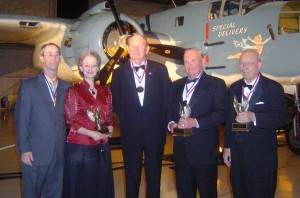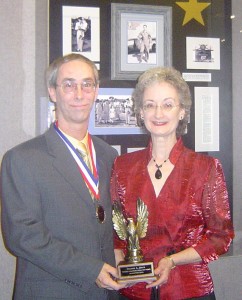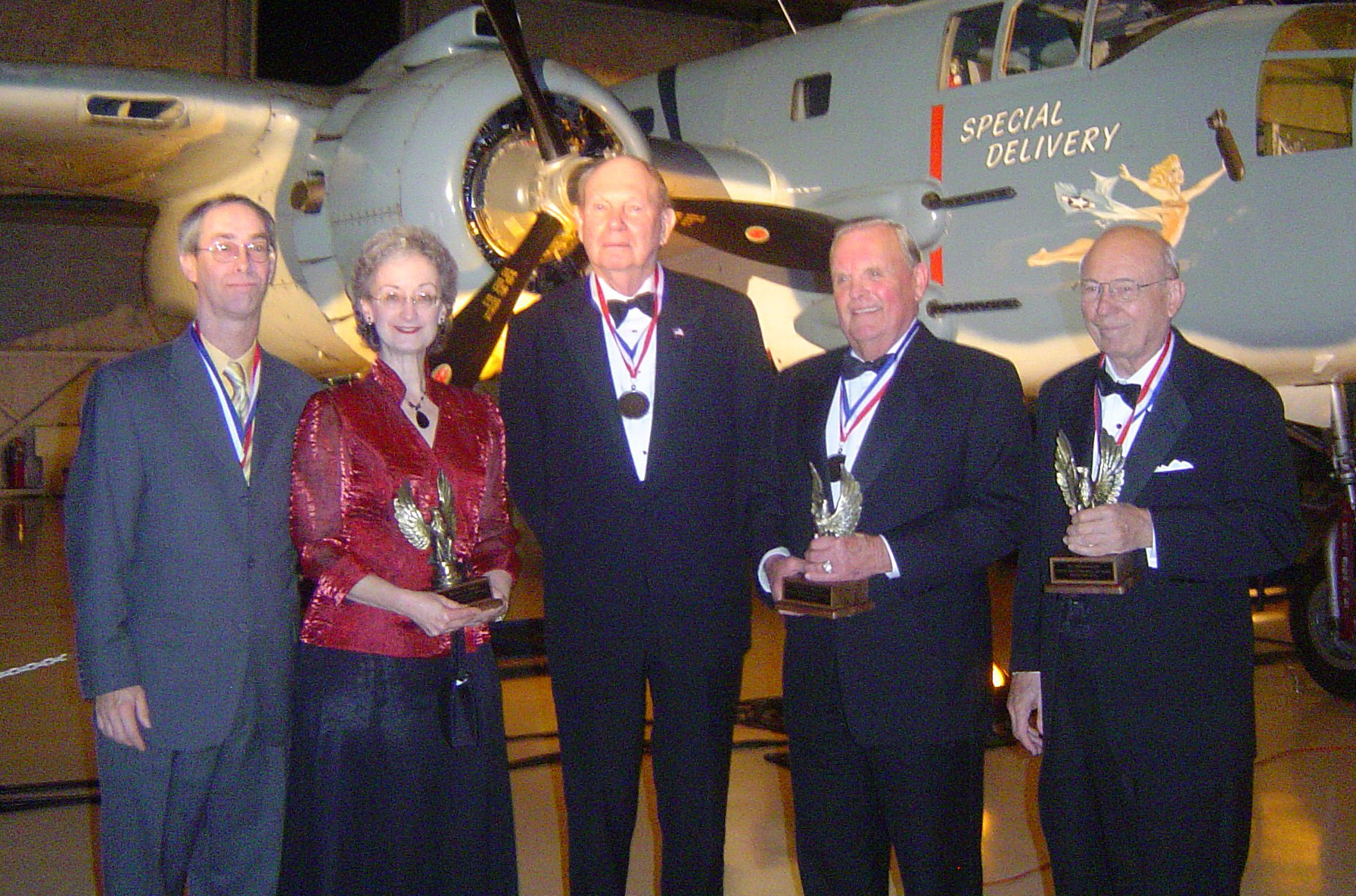By Domino Taylor

The Class of 2006 pause for a picture after the Hall of Fame induction. L to R: Charles Davis and Mary Margaret Patton (George A. Davis’ children), John F. Bookout, Robert L. Waltrip and Edward Swearingen.
The Lone Star Flight Museum launched the Texas Aviation Hall of Fame Signature Weekend with the 8th Annual Hall of Fame Induction Ceremony and Gala on November 11, in Galveston, Texas. The Texas Aviation Hall of Fame honors Texans and Texas corporations that have made outstanding contributions to the development, growth or preservation of aviation. The 2006 inductees include John F. Bookout, George A. Davis, Edward J. Swearingen and Robert L. Waltrip.
The ceremony, held Veterans Day weekend, began with a stirring posting of the colors, saluting veteran participants.
John Bookout entered the Civilian Pilot Training program and earned his private pilot certificate at age 19. He reported for Army Air Corps training in 1943 and was assigned to B-17 transition school. Upon completion, Bookout joined the 96th Bombardment Group, 413th Bombardment Squadron at Snetterton Heath Airfield, UK. From January through April 1945, he and his crew flew 19 combat missions over Germany and served as the lead crew three times. During his military career, Bookout flew more than 1,300 hours in the B-17, B-25, C-47, C-45, P-47 and numerous other training command aircraft.
He received the Air Medal with two Oak Leaf Clusters, along with many other awards and citations before he was discharged as a captain in 1946. Bookout’s professional career at Shell Oil Company spanned nearly four decades. He served as president and CEO in Houston from 1976 to 1988. He continues to serve on the board of directors of many Houston area community and philanthropic organizations and is a member of the Veterans of Foreign Wars Hall of Fame.
Lt. Col. George A. Davis flew 266 combat missions during WWII in the P-47 Thunderbolt, scoring seven aerial victories against Japanese aircraft in the Philippines. He flew another 60 combat missions in the F-86 Sabre during the Korean conflict, claiming 14 aerial victories, 12 of which came during a 17-day period.
For his last mission, Davis was posthumously awarded the Medal of Honor for valor and superb courage. While leading a combat aerial patrol mission near the Manchurian border, he sighted a formation of 12 MiG-15s, speeding toward U.S. fighter-bombers. Davis dove at the MIG formation, quickly destroying two enemy jets, and sustained his attack while under continuous fire from an enemy fighter to his rear. During the attack, his aircraft sustained a direct hit, went out of control and crashed into a mountain 30 miles south of the Yalu River, killing Davis. In addition to the Medal of Honor, Davis was awarded the Silver Star with two Oak Leaf Clusters, the Distinguished Flying Cross with three Oak Leaf Clusters, plus numerous other medals and citations.

The children of George A. Davis, Mary Margaret Patton and Charles Davis, proudly view their father’s Hall of Fame exhibit.
Ed Swearingen began his aviation career at the age of 16 as a civil service employee overhauling military airplanes and piston engines. In 1959, he formed Swearingen Aircraft in San Antonio, Texas, and controlled the design of 18 new products, ranging from small twin-engine piston airplanes to large four-engine jets. He produced the Merlin II, III and IV, as well as the Metro aircraft. In the later 1980s, Swearingen developed a small, economic corporate jet with superior capabilities in terms of speed and range. His wing design for the SJ30 enabled the aircraft to become the world’s fastest and longest-range light jet. He’s also recognized as being the first to develop exhaust gas temperature as a means of controlling fuel air ratio on small piston-powered airplanes.
Swearingen has received numerous awards throughout his distinguished aviation career. A true aviation visionary, he has left his mark across the entire field of aviation, including airplanes, helicopters, commercial airliners, corporate jets and military aircraft.
Robert L. Waltrip developed an interest in flying as a young boy during World War II, with dreams of becoming a fighter pilot. He received his private pilot license in the 1950s and enjoyed flying vintage WWII trainers, such as the Stearman and AT-6 Texan. He combined his passions for both aviation and history in 1984, when he purchased his first warbird, a B-25 Mitchell. He continued to acquire historic aircraft and quickly amassed a sizable collection.

Lone Star Flight Museum President Larry Gregory (left) and museum curator Elizabeth Smith congratulate Hall of Fame inductee John F. Bookout.
Waltrip acknowledged the growing public interest in his stable of warbirds and formed the Lone Star Flight Museum in 1985. Through his leadership and dedication, the museum quickly became one of the premiere flying museums in the world. A few examples of the many restorations he sponsored include the B-17 Flying Fortress, F4U Corsair, F6F Hellcat, F8F Bearcat and a Hawker Hurricane. He served the museum as its chairman and was a driving force behind the creation of the Texas Hall of Fame. Thanks to Waltrip’s vision, leadership and dedicated financial support, many historic aircraft and artifacts are preserved in a world class museum, for future generations to enjoy.
Immediately after the induction ceremony, each inductee’s permanent exhibit was debuted in the Hall of Fame’s education center. In addition to a picture and biography, the exhibits utilize personal artifacts, books, models, awards and other memorabilia to accurately portray each inductee’s experience and passion for aviation.
The festivities continued the next day, as the skies came to life over Galveston International Airport with the Texas Aviation Hall of Fame Fly Day. Warbirds flew over the field, signaling the end to the 2006 air show.

L to R: E.E. Vaughn, G. Hemingway and Lewis La Geese, members of the Pearl Harbor Survivors Association, sign autographs and share memories at the “Legends” table.












